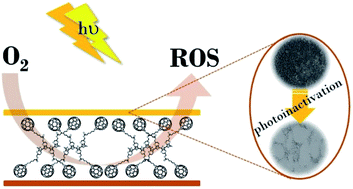Photoactive antimicrobial coating based on a PEDOT-fullerene C60 polymeric dyad†
Abstract
A photostable and photodynamic antimicrobial surface was successfully obtained and applied to photoinactivate microorganisms. This approach was based on the synthesis of a fullerene C60 derivative (EDOT-C60) where fullerene C60 is covalently linked to 3,4-ethylenedioxythiophene (EDOT) through a 1,3-dipolar cycloaddition reaction. This dual-functional monomer bears an EDOT center connected via an alkyl chain to a fullerene C60 moiety. In this structure, EDOT acts as an electropolymerizable unit that allows the film formation over conducting substrates, while fullerene C60 performs the photodynamic antimicrobial activity. Electrochemical polymerization of EDOT was used to obtain stable and photodynamic polymeric films (PEDOT-C60) in a controllable procedure. Cyclic voltammetry and UV-visible spectroscopy studies showed that the fullerene C60 units were not altered during the electropolymerization process, obtaining surfaces with high fullerene content. Photobleaching measurements demonstrated that the electropolymerized films were highly photostable. Moreover, photodynamic properties of PEDOT-C60 were compared with fullerene C60 and showed that electrodeposited films were able to generate reactive oxygen species (ROS) through the two photomechanisms, producing singlet molecular oxygen (type II) and superoxide radical anion (type I). All studies demonstrated that fullerene C60 moieties covalently attached to the polymeric matrix mainly conserve the photodynamic characteristics. Hence, photodynamic action sensitized by PEDOT-C60 was assessed in vitro against Staphylococcus aureus. The photosensitized inactivation by the electropolymerized films on bacteria suspensions produced >99.9% reduction in S. aureus survival. Fluorescence microscopy experiments with S. aureus adhered to the PEDOT-C60 surface showed a complete microbe annihilation. Also, the eradication of biofilms formed on PEDOT-C60 surfaces resulted in a photokilling >99.9% after visible light irradiation. Our results demonstrated that these antimicrobial photodynamic polymeric films are a promising and versatile platform to photoinactivate microorganisms and to obtain photostable self-sterilizing surfaces.

- This article is part of the themed collections: A celebration of Latin American research in RSC Advances and Emerging Investigators Series


 Please wait while we load your content...
Please wait while we load your content...